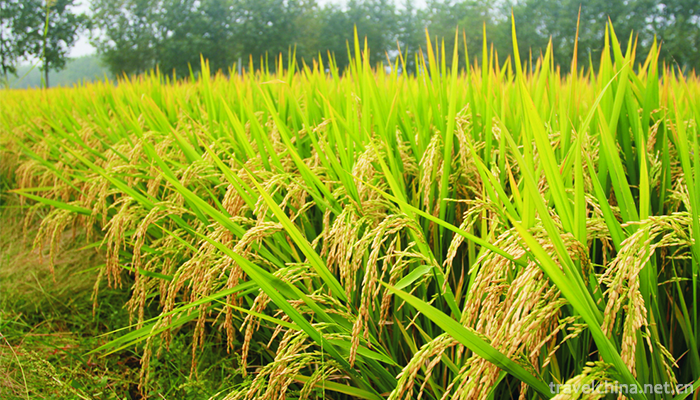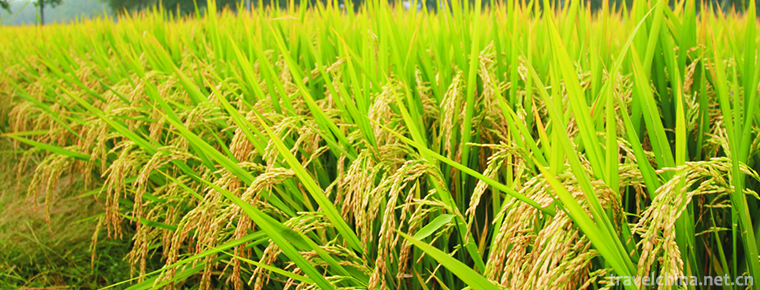Rice custom
Rice custom
Wannian rice custom and Shangrao Wannian County custom are cultural heritage. Wannian is the "land of rice". The traditional rice custom has been passed down in this area for thousands of years. Some rice custom still exists in 15 towns of the county. Wannian Gongmi is a product processed from the early variety of late indica rice "Wuyuan", originally produced in some villages of Peimei area in Wannian. It has been planted and popularized in 15 villages and towns throughout the county, with an area of 17,000 hectares. Rice culture has a long history. Millennium rice custom and Gong rice production technology have profound cultural connotations. It is a microcosm of folklore and human survival and development history, and occupies an important position in the whole ancient culture series.
Custom information
Cultural Heritage Name: Millennium Rice Custom
Date of declaration: 2006
Declarator/Declarator: Wannian County, Shangrao City
Location
Wannian is the origin of cultivated rice and tributary rice.
Wannian is located in the northeast of Jiangxi Province, the lower reaches of Le'an River and the southeast Bank of Poyang Lake. It belongs to the subtropical humid monsoon area. Wannian has a splendid ancient civilization, Dayuan immortal cave and bucket ring in the territory of ancient cultural sites known as Tu, is one of the earliest known remains of cultivated rice in the world. This new archaeological discovery pushed forward the history of rice production in the world for more than 4000 years, and was rated as the top ten new archaeological discoveries in China during the Eighth Five-Year Plan period and 100 major archaeological discoveries in China in the 20th century. When the first rice was transplanted by the primitive ancestors of Wannian Xianren Cave, the primitive farming culture of China, rice culture, began from then on. Since more than 10,000 years ago, primitive ancestors have lived the agricultural life of "rice, rice and fish". According to historical documents, rice has been the main cultivated crop in the county. In the long-term practice of rice cultivation, after thousands of years of precipitation, the primitive folk culture gradually formed the rice customs with local characteristics in the aspects of people's rumors, festivals, customs and cultivation techniques. Many rice culture customs still follow the same pattern. The long history and unique rice custom have bred the Millennium Gongmi, a local product with distinct local characteristics and profound cultural accumulation. Wannian Gongmi rice is of good quality, resembling shuttle, free jade, fragrant, soft and delicious, rich in nutrition and delicious edible. It has strong resistance to diseases, insects and cold. From the Northern and Southern Dynasties, it was a special product. In 1512 (the seven years of Zhengde in Ming Dynasty), it was called "Millennium Gongmi". 到明末清初,万年贡米被列为“国米”。 With the development of history, it has won the honorary titles of high-quality rice from provinces, ministries and international markets, export inspection-free products and "green food". Wannian Gongmi has become the top quality of rice that people can rest assured of eating.
The growth and cultivation of Millennium Gongmi have unique requirements for climate, soil, water and other environments. Over the past ten thousand years, the people have summed up a series of traditional rice production technologies, such as cultivation and renewal of improved varieties, sowing and transplanting, field management, harvesting and storage, and refined processing. Millennium rice custom and Gong rice production technology have profound cultural connotations. It is a microcosm of folklore and human survival and development history. It occupies an important position in the whole ancient culture series. It has far-reaching historical and cultural value, important agricultural research value and considerable economic value.
Shanxun: The emergence of new high-quality rice varieties such as forest competition, coupled with the limitations of paddy planting areas in Wannian, the lag of conservative production and management technology, the gradual degradation of rice customs, the traditional technology and culture of paddy rice in Wannian are on the verge of extinction. In order to inject new vitality into this traditional culture and pass it on from generation to generation, the "Millennium Rice Custom and Millennium Gongmi Production Technology" is declared for the protection of national intangible cultural heritage. The region and its geographical environment are the origin of cultivated rice and the origin of Millennium rice.
Wannian has a splendid ancient civilization, Dayuan immortal cave, bucket ring site is one of the earliest known rice cultivation relics in the world. With a long history and suitable natural environment, the Millennium Gongmi, a local product with distinct local characteristics and profound cultural accumulation, has developed its unique rice custom.
basic feature
Characteristics of Gongmi Rice
Leaf blade is long and narrow with thick hairs, oblique front and back, strong resistance to diseases and insects, thin ridge resistance and less fertilizer requirement.
Characteristics of Gongmi Products
Rice is of good quality, with fine grains, shuttle-like shape, free-flowing quality, medium-length at both ends after absorbing enough water, soft but not sticky, delicious, nutritious, calcium content 42-448.4mg/kg, zinc content 16.4-21.4rog/kg, iron content 0.44-0.55mg/KG.
Main value
Rice culture has a long history. Millennium rice custom and rice production technology have profound cultural connotations. It is a microcosm of folklore and human survival and development history. It occupies an important position in the whole ancient culture series. Its value has three main points:
Agricultural value
Gongmi is the best and precious product in rice. Its planting and popularization is an important agricultural subject. Moreover, Gongmi is a natural pollution-free green product.
Products, which do not contain any harmful substances, are very beneficial to people's physical health, and can meet the needs of modern Du: people will need health care.
economic value
For a long time, Gongmi has been a pillar industry for thousands of years, playing a very important role in the local economic development. First of all, the development of Gongmi processing industry has solved the employment problem of a considerable number of local people. Secondly, Gongmi belongs to agricultural products, which can effectively promote agricultural efficiency and increase farmers'income. Every year, Zhejiang businessmen sign orders directly with local government farmers in Wannian to guarantee the sale of all products. In addition to some exports, 40% of Gongmi in Wannian is exported to Zhejiang and 30% to Guangdong and Fujian. Only 20% of the province's sales, annual output value of more than 200 million yuan.
Historical and Cultural Value
The earliest history of rice can be traced back to the Neolithic Age. The earliest cultivated rice remains found in the world at Xianren Cave and Hanging Barrel Ring sites in Wannian can prove that the Millennium rice custom history and the production technology of Gong rice have a long history and have lasted for more than 10,000 years. For a long time, as an important cultural carrier, it has played a great role in the continuation of Chinese civilization and even the world civilization, and has a high value in the study of rice culture and food culture.
Endangered situation
10,000 years of traditional Gongmi shavings light, temperature duality, resistance to sleeping and high temperature, resistance to back drought, narrow and long leaves, small stems, softening and easy to collapse after maturity, reproduction has obvious regional limitations, which makes it difficult to popularize planting cypress.
2. Farmers in other regions have blindly planted Gongmi, regardless of geographical constraints. As a result, some fake Gongmi with poor quality and color and taste flooded the market.
3. Due to the improvement of material living conditions, the custom of holding rice on traditional festivals has gradually faded away, such as making rice fruits in Lantern Festival, making rice fruits in Qingming Dynasty and making rice cakes at the end of the year.


-
2.Big and Small Size Dongtian Scenic Spot
The Size Dongtian Scenic Area (formerly known as the Haishan Scenic Spot and Aoshan Scenic Spot) is located in the southern corner of Nanshan Province, 40 kilometers west of Sanya City
Time 2018-12-12 -
3.Jiangshan Peninsula Tourist Resort
Jiangshan Peninsula Tourist Resort is a provincial tourism resort development zone approved by the People's Government of Guangxi Zhuang Autonomous Region in 1994.
Time 2019-01-21 -
4.Heap harmonics
"Heap Harmony" first spread in the Yarlung Zangbo River Basin, the high terrain west of Shigaze to the whole area of Ali circle dance, and later gradually prevailed in Lhasa. It was the firs
Time 2019-04-28 -
5.Rubbing and Printing Skills of Hengshui Inscriptions
Hengshui Law Tie Engraving and Printing Technology, the traditional handicraft of Taocheng District, Hengshui City, Hebei Province, is one of the national intangible cultural heritage.
Time 2019-05-03 -
6.Gourd sculpture
There are two techniques for carving gourds. One is to use three kinds of special steel needles, large, medium and small, to carve the landscape, flowers and characters in the gourd
Time 2019-05-03 -
7.Flower Huaer
"Huaer" is a folk song created and shared by Han, Hui, Tibetan, Dongxiang, Baoan, Sarah, Tu, Yugu and Mongolian nationalities in Gansu, Qinghai and Ningxia provinces in Northwest China.
Time 2019-05-04 -
8.Wheat straw cut and paste
Straw clipping is a traditional folk handicraft. Also known as "wheat straw clipping", "wheat straw clipping". Using the natural luster of wheat straw and the characteristics of ru
Time 2019-05-16 -
9.Pingnanping Opera
Pingnanping opera is a kind of traditional opera with a history of 400 years. As the predecessor of Fujian opera, the main features of the opera are that Taobai singing uses Fuzhou Mandarin, the front
Time 2019-06-09 -
10.Wuyin Opera
Wuyin opera has a history of nearly 300 years. Its singing style is graceful and charming. It is known as "Northern Yue Opera". Its occurrence, development and finalization have gone through
Time 2019-06-29 -
11.Bamboo weaving
The traditional bamboo weaving technology has a long history and is rich in the crystallization of the hard work of the working people of the Chinese nation. Bamboo weaving crafts are divided into fin
Time 2019-08-10 -
12.Cao Tiancheng
Cao Tian Cheng, Sui Dynasty people. According to the history of Sui Dynasty in the twenty four histories, Cao Tian is also known as "Tiancheng". Ask for advice Bo Yang, Jiangxi. At the end o
Time 2019-09-14